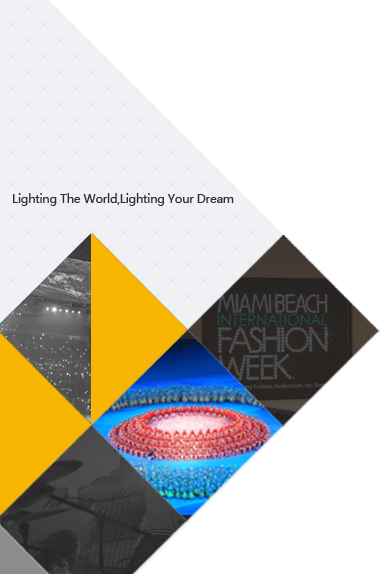-
- Branch Companies
- Glux Shenzhen (Tech) Co., Ltd

Overview of visual effect
Stage of performing arts
Along with the recent years’ development of scientific technology and the constant improvement of digital technology, the performance visual-effect system represented by digital devices becomes a significant promoting power of stage digitalization. Among the basic components of modern stage such as the stage visual effects, lights, machines, sound effects, special effects and the digital instruments, the stage visual effects, as a new member in this family, is a significant evolutionary element for the present performance stage’s construction, which will also lead to a significant change of stage technology and usage via its developments and progress.
Stage performance visual effect
This is a kind of visual effect performing system which combines various videos together and constitutes the modern performance space under the operation of the smart broadcasting and controlling system. It usually consists of visual effect unit, boarding system, power system and display materials and is equipped with functions such as scene design, interaction between virtual things and reality, stimulation demonstration and integrated command, and it works as a significant component of the digital performance space nowadays.
Beijing Glux
As the developer of performance visual effect, Glux has been devoting itself to using technological innovation to service the cultural idea since its establishment. By means of constant innovation of visual effect application and products, Glux implanted artistic visual effect elements into performance sector, thereby promoted the revolutions and progress of stage art and television art. So far, Beijing Glux has become one of the most-experienced service providers with the most comprehensive and complete service and products.
Stage visual effect
Performance stage
In recent years, digitalization has been the trend of the performance visual effect industry, the performance visual effect system represented by digital equipment performing arts is an important driving force. Among the basic components of the modern performing stage such as stage visual effect, lighting, machine, sound, special effects and digital props etc., the stage visual effect, as a new member, is an important reforming element in building today's performing stage, whose development and progress will lead the significant progress in the stage technology and its application.
Stage visual effects
This is a kind of visual effect performing system which combines various videos together and constitutes the modern performance space under the operation of the smart broadcasting and controlling system. It usually consists of visual effect unit, boarding system, power system and display materials and is equipped with functions such as scene design, interaction between virtual things and reality, stimulation demonstration and integrated command, and it works as a significant component of the digital performance space nowadays.
Stage visual effect system is developed along with the constant innovation of stage art design, which is a significant component of stage performance. The task of stage art design is to apply various artistic means in a unified art conception based on the content of script and requirements of performance, in order to create the external image besides the environment and characteristics in the play, therefore to exaggerate the stage’s atmosphere. The stage art design in the early years mainly refers to the stage art design of traditional dramas, while the design of stage is just the scenery-setting, namely applying real setting to serve for virtual dramas. In pace with the growing number of performance art forms, as well as the preference of TV culture and the public’s appreciation for beauty, performance designs gradually engaged more in showrooms, squares, stadiums and other venues, and the stage design of these large-scale celebration parties is also named as artistic design for variety show stages. The background of stage also experienced the stages from set to lighting, projection and then to stage visual systems.
(1)In the beginning of the 20th century, stage setting appeared along with the appearance of performance stage.
In 1908, the first new stage with modern devices was established in Nanshi, Shanghai. With Japanese model as a frame work for reference, the new stage was constructed based on a traditional Shanghai-style tea garden by changing the previous square stage into a crescent shape. Besides, the stage backgrounds were changed by switching a setting to another.
Generally speaking, the earlier stage settings were designed by artistic methods of symbolism, metaphor, patterning, decoration, exaggeration and deformation etc. On the whole, the stage backgrounds at that time could be safely described as preliminary, low-leveled and monolithic.
(2)Computer-controlled stage settings emerged in 1980s
TV wall and projected screen background appeared with the development of computer technology in late 1980s. In this period, the static backgrounds were usually made by overhead projectors and until recently, the moving light was adopted; while dynamic backgrounds were enabled by playing movies.
(3)Stage settings stepped towards digitalization and intelligentization in the year of 2000
When it comes to the 21st century, performance visual-effect system appeared, and when its technology came into maturity, it gradually replaced the traditional methods and was used for the display in the background settings on stage. In the performance, scenes appeared on big screens which match the performed program and therefore replaced the function of real background settings.
Compared with the lights used on traditional stages, digital visual effects system affords rich expressions and strong artistic effects. In addition to its unprecedented flexibilities in simulating realities, reproducing nature and image effects, the system also has some characteristics of light source just as which of other lighting systems. The information perceived by audience from videos is far greater than what is delivered by traditional stage backgrounds and physical devices like lights. Besides, the virtual pictures created by the system bring the perfect harmony of lights and arts. Currently, the stage visual effects system technology has provided an entirely fresh displaying approach to light applications in film performance and TV studios.